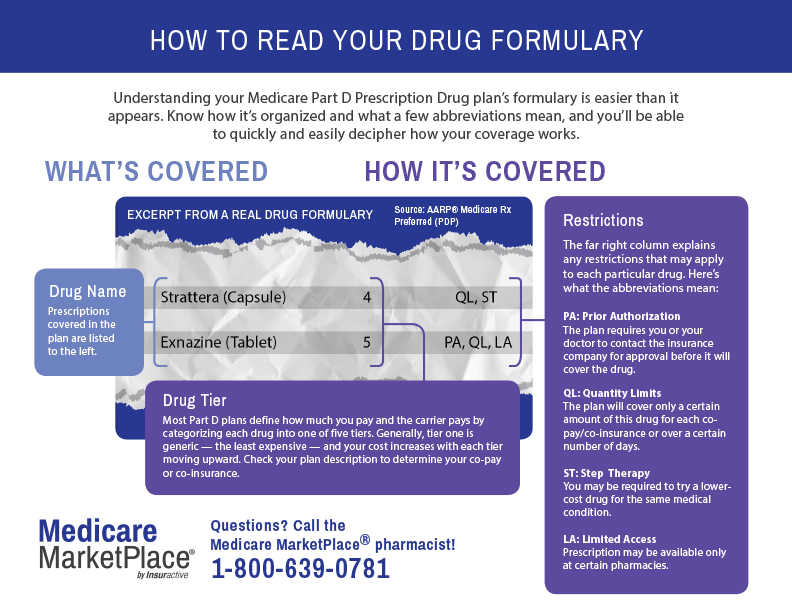Information you need to live a happy, worry-free retirement!
Originally published June 6, 2017, last updated December 15, 2017
How to Read Your Medicare Part D Drug Formulary
At first glance, your Medicare Part D Prescription Drug formulary can be intimidating and downright confusing. But if you understand how it’s organized and a few abbreviations, you’ll be equipped to save money and prevent frustrating delays in getting the drug therapy you need. Medicare MarketPlace® will help you navigate how to read your drug formulary.
What Is a Part D Formulary?
A formulary is a list of drugs covered by an insurance plan. It also shows how they are covered — how much you pay, how much the plan pays and any prerequisites or restrictions on getting it paid. Formularies assign each medication to a tier, depending on safety and total cost. Many Medicare formularies use a five-tiered system, in which inexpensive, preferred generics fall under tier one and more expensive specialty drugs occupy tier five. In general, a lower tier drug will cost you less than a drug in a higher tier.
You probably received a copy of your formulary when you enrolled in your Medicare Part D Prescription Drug plan. If you aren’t sure where your plan formulary is, you can usually find a current version online or request one directly from your insurance carrier.
How Drug Formularies Are Organized
Formularies are often dozens of pages long but are organized rather simply:
- What’s covered — drug names are listed to the left, grouped alphabetically by therapeutic category
- How it’s covered — a middle column lists the tier number assigned to each drug, and a right column lists the abbreviations for any restrictions
What Are Restrictions and All Those Abbreviations?
Formulary medications covered by the plan often have additional restrictions to coverage, such as prior authorization, quantity limits, step therapy and limited access. These are abbreviated in the columns to the right of the drug name. The drug formularies should have a key and explanation for you to refer to, so you don’t have to remember the abbreviations and what they mean.
PA = Prior Authorization
This means that before the plan will cover a particular drug, your doctor or other prescriber must first show the plan that it’s medically necessary for you to have that particular drug. Medications requiring prior authorization may or may not be approved depending on patient-specific information provided by your physician.
Example: Norm has been on a medication for a heart condition for several years. His new insurance plan requires a prior authorization for this medication. Norm’s doctor submits the required prior authorization form. In the meantime, Norm is entitled to a transitional supply, so he gets that filled until the prior authorization is approved. A week later, his pharmacist calls to inform Norm that his medication has been approved for the rest of the year.
QL = Quantity Limits
Plans may limit the amount of drugs they cover over a certain period of time for safety and cost reasons. They may limit how much you can receive each month or each calendar year. These specific amounts are often outlined for each medication later in the formulary.
Example: Leonard takes a sleeping medication about once a week. His plan formulary allows him to have a quantity of 90 tablets each calendar year. Because of how frequently Leonard takes his sleeping pill, he will not exhaust his 90-tablet allowance before the end of the year. But if he did exhaust it before the end of the year, he would need to pay the full retail cost after the first 90 tablets are covered.
ST = Step Therapy
Step therapy often requires patients to try alternative, less-expensive medications first, before you can move up a “step” to a more expensive drug.
Example: Ida is prescribed a blood pressure medication that is not covered until two alternative blood pressure medications have been tried. Ida has in fact tried those two alternatives in the past, and they didn’t control her blood pressure well. The physician provides that information to the insurance company, and the insurance company approves the medication that the doctor prescribed.
Requesting an Exception
You, your doctor or your representative can request an exception to the coverage rules. For example, you can request that a plan:
- cover a medication that isn’t on the plan’s formulary
- waive restrictions or limits on a medication
- provide coverage for a formulary drug under a lower cost-sharing tier
Your prescribing doctor must submit a supporting statement orally or in writing. To learn more about the process or requesting an exception, visit the CMS.gov website.
Need Answers to Formulary Questions?
Even if you understand how to read your formulary, you may still have questions. Medicare MarketPlace has an on-staff pharmacy director who can help you decipher your formulary. Just call Medicare MarketPlace at 1-800-639-0781 and ask for Ryan Vlasin or email him at pharmacist@insuractive.com.

Ryan VlasinPharmacy Director
Confused about your Medicare Part D Prescription Drug coverage?
Ask the Medicare MarketPlace® pharmacist. Email your question to Pharmacy Director Ryan Vlasin at:




